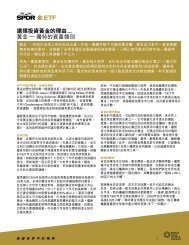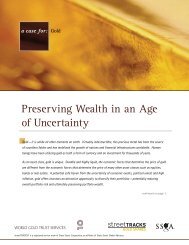Create successful ePaper yourself
Turn your PDF publications into a flip-book with our unique Google optimized e-Paper software.
Portfolio construction and gold effectIn order to isolate the portfolio impact of a decision to hedgeemerging-market exposure with gold, we compare threeportfolios: 1) with an unhedged emerging market index (in USdollar terms); 2) with a currency-hedged emerging-market index;and 3) with an emerging market hedge strategy split 50/50between a currency hedge and a gold overlay. 26 That is to say,gold is a borrowed asset added on top of the existing portfolio.It does not therefore reduce allocations to existing assets orthe original capital invested, in keeping with the way overlayhedges are commonly constructed. Thus, a 50% gold overlayto the 10% emerging market equity exposure resulted in a netexposure of an additional 5% allocation to gold, at the portfoliolevel, funded by a 5% borrowed cash position. So as not tosurpass the total capital available for investment, gold must beborrowed to construct the overlay – for which there naturally isa fee. We have penalised gold returns over the period using ashort-term cash rate as a benchmark for borrowing costs.Table 3 summarises the return, volatility and information ratiosof the three portfolios under consideration. The full-periodresults show the net effect of these contrasting dynamics.In particular, the results show that a combination of gold andforeign-exchange hedging would have provided the best returnper unit of risk over the 2002 to 2012 period. The case foradding gold to the overlay between 1987 and 2001 was slightlyless compelling as the period experienced both a decline in theprice and only a modest reaction to regional crises.While including a gold overlay increased volatility as a resultof leverage (more capital put to work financed by a very lowvolatility instrument), the portfolio return obtained compensatedinvestors for the additional price volatility. Consistent withaforementioned findings, a foreign-exchange hedged portfoliodecreased portfolio volatility significantly during the full periodbetween 1987 and 2012, but only increased returns during1987-2001, and not during 2002-2012. However, the informationratio of the portfolio containing the currency-hedged emergingmarketequities was higher than the portfolio containing anunhedged emerging-market index during the period from 1987to 2001. In summary, the 50/50 combination of local-currencyhedging and a gold overlay stood as the most compellingstrategy, especially considering the structural shift observed inemerging markets over the past decade.26 To provide the comparison with foreign-exchange hedges on equal terms, we have introduced gold here as an overlay and have set the strategic allocationto gold at 0%. However, previous research by the World <strong>Gold</strong> Council has shown that long-term strategic optimal allocations to gold can range from 2% to10% and are significantly different from zero.<strong>Gold</strong> <strong>Investor</strong> | Risk management and capital preservation










